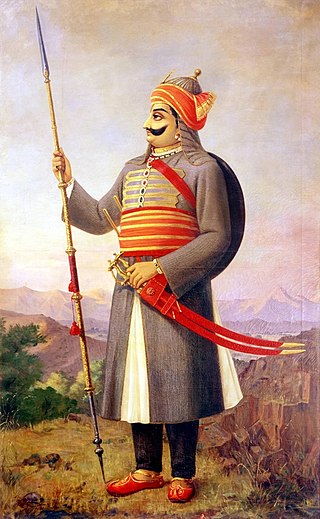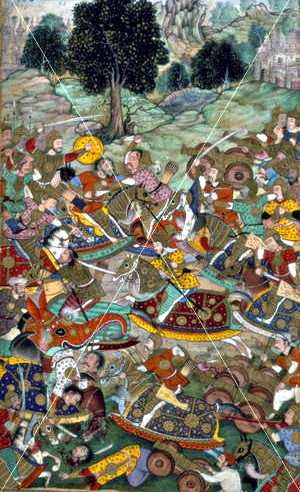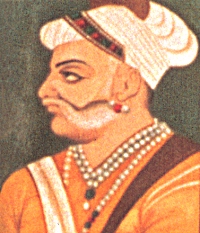This article relies largely or entirely on a single source .(January 2022) |
Mir Abdul Aziz | |
|---|---|
| Allegiance | Mughal Empire |
| Rank | Commander |
| Battles/wars | Battle of Bayana Battle of Khanwa |
Mir Abdul Aziz was a commander in the Mughal Empire.
This article relies largely or entirely on a single source .(January 2022) |
Mir Abdul Aziz | |
|---|---|
| Allegiance | Mughal Empire |
| Rank | Commander |
| Battles/wars | Battle of Bayana Battle of Khanwa |
Mir Abdul Aziz was a commander in the Mughal Empire.
Abdul Aziz was appointed by Babur to lead an advance guard to check Rana Sanga's advance. However he was defeated at the Battle of Bayana. [1]
In 1527 Abdul Aziz participated in the Battle of Khanwa where he led a contingent of the Mughal Army and the Mughals inflicted a defeat on the Rajputs led by Rana Sanga during this battle. Rana Sanga got badly wounded by an arrow during the battle and was subsequently removed from the battleground in unconscious state by Prithviraj Kachwaha of Amber. [2]

Sangram Singh I, commonly known as Rana Sanga, was the Rana of Mewar from 1508 to 1528 CE. A member of the Sisodia dynasty, he controlled parts of present-day Rajasthan, Gujarat and Madhya Pradesh with his capital at Chittor. His reign was admired by several of his contemporaries, including the first Mughal Emperor Babur, who described him as the "greatest Indian ruler" of that time. The Mughal historian Abd al-Qadir Badayuni called Sanga the bravest of all Rajputs along with Prithviraj Chauhan also known as Rai Pithaura.

Pratap Singh I, popularly known as Maharana Pratap, was a king of Kingdom of Mewar, in north-western India in the present-day state of Rajasthan. He is notable for leading the Rajput resistance against the expansionist policy of the Mughal Emperor Akbar including the Battle of Haldighati and the Battle of Dewair.

The Battle of Khanwa was fought at Khanwa on 16 March 1527. It was fought between the invading Timurid forces of Babur and the Rajput Confederation led by Rana Sanga for supremacy of Northern India. The battle was a major event in Medieval Indian history although Timurids won at Panipat but at the time, the sultanate at Delhi was a spent force that was long crumbling. To the contrary, Kingdom of Mewar under the able rule of Rana Sanga, had turned into one of the strongest powers of northern India. Therefore, the battle was among the most decisive battles in the Mughal conquest of northern India. It was among the earliest battles in Northern India where gunpowder was used to a great extent. The battle resulted in heavy casualties for both Timurids and Rajputs.

Rao Maldeo Rathore was a king of the Rathore dynasty, who ruled the kingdom of Marwar in present day state of Rajasthan. Maldeo ascended the throne in 1531 CE, inheriting a small ancestral principality of Rathore's but after a long period of military actions against his neighbours, Maldeo swept significant territories which included parts of present day Rajasthan, Haryana, Uttar Pradesh, Gujarat and Sindh. He refused to ally with either the Sur Empire or the Mughal Empire.

The battle of Haldighati was fought on 18 June 1576 between the Mewar forces led by Maharana Pratap, and the Mughal forces led by Man Singh I of Amber. The Mughals emerged victorious after inflicting significant casualties on Mewari forces, though they failed to capture Pratap, who reluctantly retreated persuaded by his fellow commanders.

The Kingdom of Amber, later known as the Jaipur State and also the Kingdom of Jaipur, was located in the north-eastern historic Dhundhar region of Rajputana and was ruled by the Kachwaha Rajput clan. It was established by Dulha Rai, possibly the last ruler of the Kachchhapaghata dynasty of Gwalior who migrated to Dausa and started his kingdom there with the support of Chahamanas of Shakambhari in the 12th century. Mostly through 12th to 15th century, the kingdom faced stagnation, sources were scarce. Under its ruler, Raja Chandrasen of Amber became a Sisodia vassal and fought in the Battle of Khanwa under Raja Prithviraj Kachhwaha.

The history of human settlement in the western Indian state of Rajasthan dates back to about 100,000 years ago. Around 5000 to 2000 BCE many regions of Rajasthan belonged as the site of the Indus Valley Civilization. Kalibangan is the main Indus site of Rajasthan, here fire altars have been discovered, similar to those found at Lothal.

The Kingdom of Mewar was an independent kingdom that existed in the Rajputana region of the Indian subcontinent and later became a major power in medieval India. The kingdom was initially founded and ruled by the Guhila dynasty followed by the Sisodiya Dynasty. The kingdom came to be known as the Udaipur State after it became a princely state in the nineteenth century.

Kingdom of Marwar also known as Jodhpur State during the modern era, was a kingdom in the Marwar region from 1243 to 1818 and a princely state under British rule from 1818 to 1947. It was established in Pali by Rao Siha, possibly a migrant Gahadavala noble, in 1243. His successors continued to struggle against regional powers for domination and 9 out of 15 rulers till 1438 died in combat. In 1395, its capital was changed to Mandore by Rao Chunda of Mandore and to Jodhpur in 1459 by Rao Jodha.
The Mughal–Rajput wars were a series of battles between the Rajput Confederacy and the Mughal Empire. The conflicts originated with the invasion of northwestern India by the Mughal ruler Babur, to which the head of the Rajput confederacy, Rana Sanga, offered staunch resistance. The conflicts went on since 1526 for over 200 years, with the Mughals having the upper hand until the death of Aurangzeb in 1707, following which they entered a declining phase and the Rajputs gained the upper hand, with the last recorded conflict taking place in 1779.
The Battle of Dholpur in today's India occurred between the Kingdom of Mewar, led by Rana Sanga, and the Lodi dynasty of the Delhi Sultanate, commanded by Ibrahim Lodi, culminating in a victory for Mewar.

The Battle of Gagron was fought in 1519 between Mahmud Khalji II of Malwa and Rajput Confederacy of Rana Sanga. The conflict took place in Gagron and resulted in Sanga's victory, with him taking Mahmud captive and annexing significant territory.
In 1520 A.D. Rana Sanga led a coalition of Rajput armies to invade Gujarat. He reinstated Raimal Rathore as the Rao of Idar and defeated the Gujarat forces under the command of Nizam Khan. Rana Sanga drove the army of Muzaffar II deep into Gujarat and chased them up to Ahmedabad. The Sultan of Gujarat was forced to flee to Muhammadabad. After a series of successful military campaigns Sanga successfully captured Northern Gujarat.

Rao Ganga was the Rathore Rajput ruler of the Kingdom of Marwar. Rao Ganga ascended to the throne in the year 1515 through the support from his kinsmen and nobles. During his reign, the Rathores consolidated and expanded their rule in eastern Marwar.
Banvir, also known as Banbeer was the ruler of Mewar Kingdom between 1536 and 1540. He was nephew of Rana Sanga, born to his brother Prithviraj and his cocunbine.
Raja Prithviraj Singh I, also known as Prithvi Singh I, was the 16th-century Kachwaha Rajput ruler of Kingdom of Amber. He was a monarch of strong religious inclinations and during his reign, the Kingdom of Amber became increasingly politically active. He took part in the Rajput alliance against Mughal Emperor Babur, fighting against the latter in the Battle of Khanwa alongside Rana Sanga of Mewar in the year 1527. Three of Raja Prithviraj's sons successively followed him as ruler of Amber, with many of his descendants also populating the kingdom's highest aristocracy in subsequent centuries.
The Battle of Bayana or the Siege of Bayana was a military conflict between the Rajput Confederacy under Rana Sanga on one side and Afghan of Bayana under Nizam Khan and Mughal advance guard, led by Abdul Aziz on other side.

The Mewar–Malwa conflicts were a series of wars between the Kingdom of Mewar and the Sultanate of Malwa. The conflict erupted due to mutual territorial expansion triggered by both sides on each other. The war was fought in the modern-day regions of Rajasthan and Madhya Pradesh. The Rana branch of the Guhilas, following their successful recovery of the Rajput stronghold of Chittorgarh and the entire region of Mewar alongside Rajputana after the Battle of Singoli, embarked on an ambitious expansion at the cost of their neighboring kingdoms. On the other side, with the invasion of Timur, the Delhi Sultanate grew weak and many of its provinces gained independence which included Malwa, adjacent to Mewar.
From Baburs memoirs we learn that Sanga's success against the Mughal advance guard commanded by Abdul Aziz and other forces at Bayana, severely demoralised the fighting spirit of Baburs troops encamped near Sikri.
As the battle raged on, the tide inexorably turned against Sanga. Severely wounded, Sanga lost consciousness and in that state, was carried away from the battlefield by loyal supporters to a nearby site called Baswa